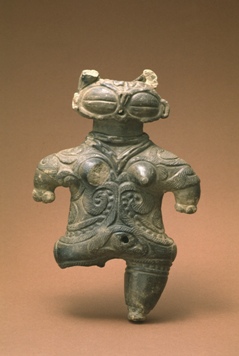SAM Art: Representatives of a Forgotten Past
This fall, Hattie Branch, Blakemore Intern for Japanese Art, will share additional information about a series of masterpieces in Luminous: The Art of Asia, the current special exhibition. This is her first entry.
Works of prehistoric art stand before us, modern viewers, as ambassadors of a forgotten past that still resonates with us today. Luminous includes two such prehistoric works from Japan: a small figure with distinctively bulging eyes called a Dogū, and a large, stout, terracotta soldier called a Haniwa. Separated by approximately thirteen centuries, together they represent artistic highlights of prehistoric Japan, and embody ideas of surrogate personhood that endure to the present.

Dogu (clay figurine), Japanese, Final Jomon period (1000 - 400 B.C.), terracotta, 9 1/4 x 6 ¼ in., Floyd A. Naramore Memorial Purchase Fund, 76.35
The Dogū comes from early in the Final Jōmon Period (ca. 1000-300 BCE). The Jōmon people were hunter-gatherers known for their ceramic pottery marked with rope impressions, visible here as the swirled texture on the Dogū’s surface. Knowing that she comes from an excavation in Northern Japan, it is logical to read the patterning across her torso as a heavy robe in the colder northern climate. Her stunningly large eyes are now believed to be exaggerated to emphasize their importance as “windows to the soul”. Although possibly used for some sort of ritual, likely for fertility or healing, the exact purpose of this little alien-faced lady is uncertain.

Haniwa warrior figure, 6th-7th century, Japanese, Kofun period (3rd-7th century C.E.), ceramic with polychrome, 53 ¼ x 16 ½ x 10 ¾ in., Eugene Fuller Memorial Collection, 62.44
The orange terracotta Haniwa comes from late in the Kofun Period (3rd-7th century CE), an era named for its distinctive, large keyhole shaped tomb mounds (kofun) primarily built in the Southern portions of Japan. Far removed from the Jōmon, the Kofun Period came after the establishment of agriculture and metallurgy, a time that gave rise to powerful clan governments. The heavy armor worn by the Haniwa is a testament to authority grounded in military prowess. Unlike the Dogū, whose past remains mysterious, the Haniwa is assuredly bound to a funereal use. These terracotta figures of people, horses, birds, and even houses ringing a huge tomb mound, their orange thrown into sharp relief against the gray stone paving the tomb’s surface, and reflected in the waters of a surrounding moat would have been unearthly and awe-inspiring to the people of the time, only later becoming hidden by untended foliage.
While created at different times and with different techniques, both of these figural works were made using the ceramic technologies of their own times, the same technologies used in the manufacture of humble vessels. The Dogū features the same burnished black color and cord imprints as jars. The Haniwa, similarly, was made with the same terracotta and cylindrical form construction used to make pots. Indeed, both figures can be seen as highly complex, symbolic vessels.
As surrogates for or memories of the living, Dogū and Haniwa are believed to have become vessels for the soul. In the landmark The Birth of Japanese Art (1965), Edward Kidder describes many Dogū as found seemingly deliberately broken or buried in clay-lined holes, suggesting that they were used in healing or fertility rituals as a surrogate for a specific living person. He goes on to describe the placement of Haniwa around tomb mounds as enacting actual funeral processions and rituals, the ceramic figures replicating ritual action in perpetuity.
Perhaps most significant about this correspondence is how the value of these figures resonates across time. We still find these creations so compelling as to feel certain that they must be identifiable with personhood, in possession of a soul. Dispossessed of their context, they still appear familiar, filling us with awe.